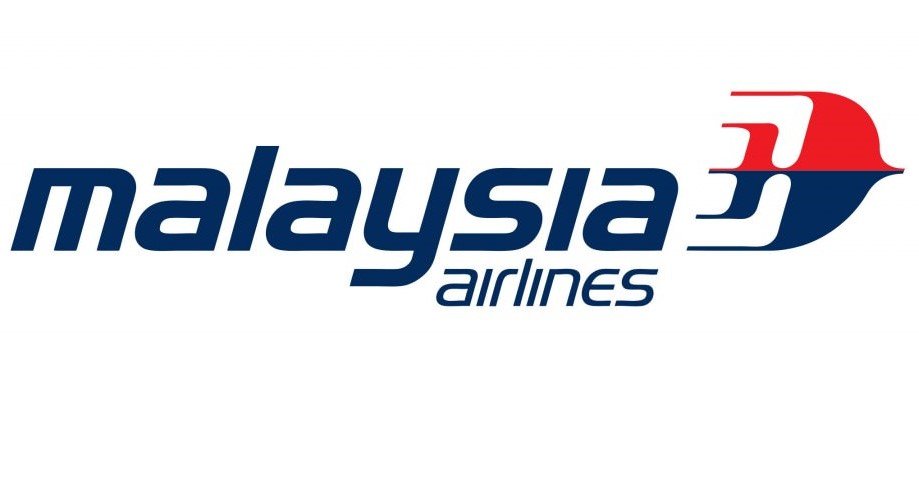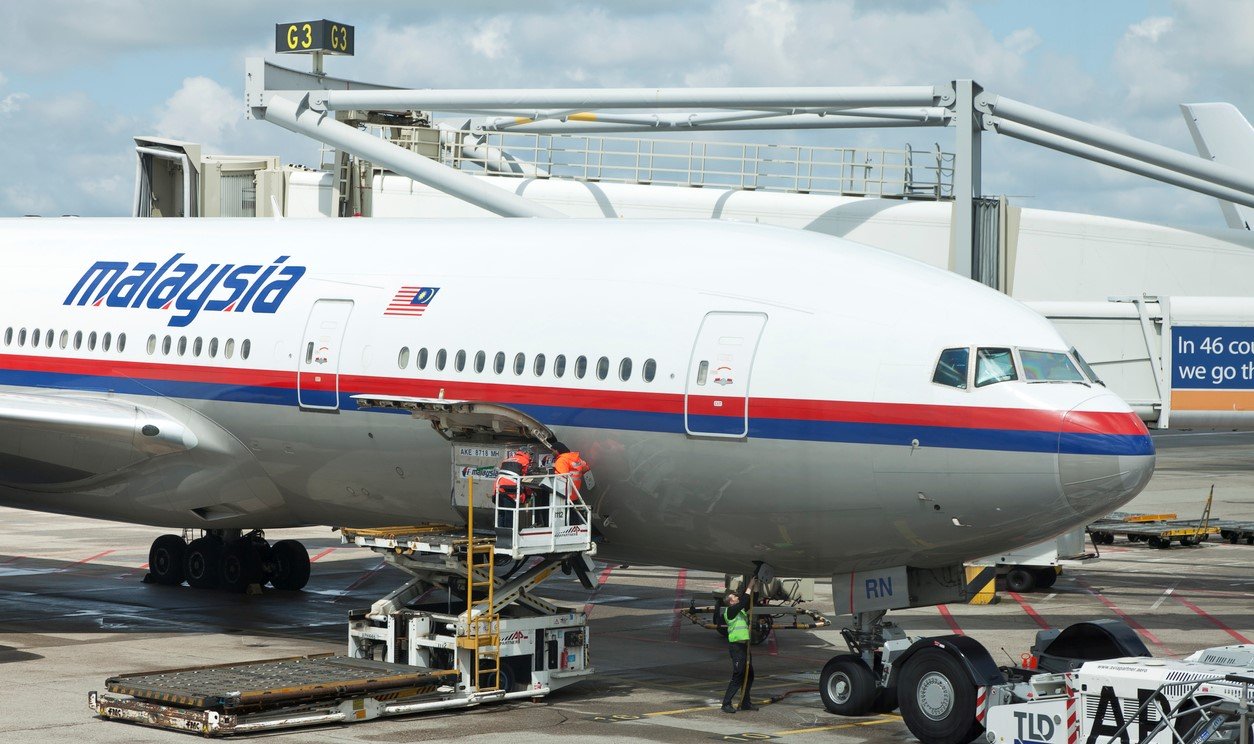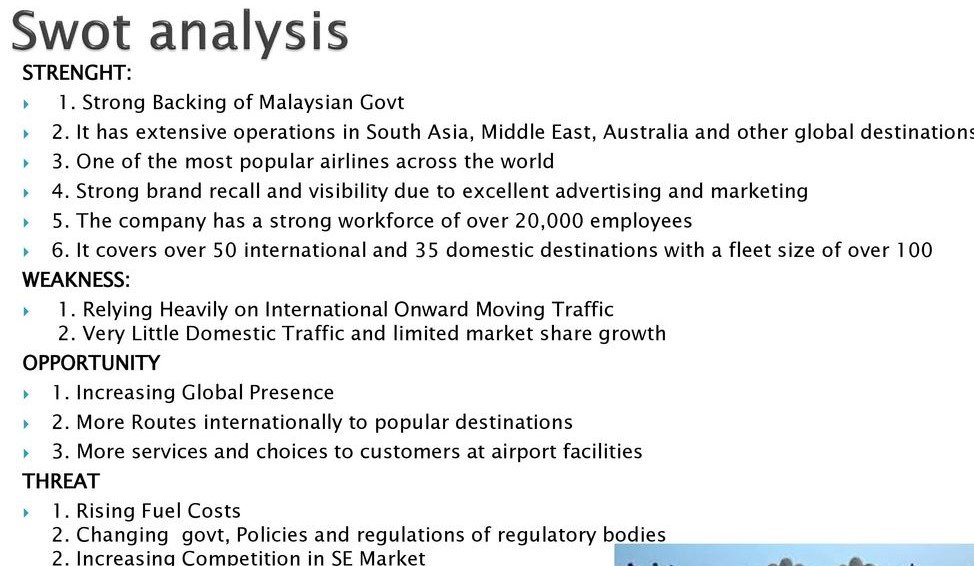Malaysia Airlines SWOT analysis – SWOT analysis of Malaysia Airlines: Malaysia Airlines is an airline that has flights operating from its hub located in Kuala Lumpur. The airline was recently rebranded as Malaysia Airline Berhad and operates flights to Asia, Australasia, Africa, and Asia, Africa, Australasia Americas, Europe, and the Middle East. The airline was first established in 1930 in Singapore with the initial flight taking off in 1947. Today, the aircraft is operated out of Kuala Lumpur International Airport. Kuala Lumpur International Airport as its hub. It connects to approximately 61 destinations around the globe.
The company operates a fleet size of about 78 aircraft through the two subsidiary companies Firefly as well as MA Swings. Malaysia Aviation Group which is the parent company of Malaysia Airlines has operations in areas such as Air Transportation Services, Ground Services, Aircraft Leasing, and Talent Development. The airline had annual revenue of 60 million Malaysian Ringgit in 2017 and employs approximately 14,000 people.
Malaysia Airlines fun facts: Malaysia Airlines Flight 370 disappeared in March while en route from Kuala Lumpur to Beijing. It has not been found, but the search has been concentrated in the Indian Ocean far west of Australia.
About Malaysia Airlines – SWOT analysis of Malaysia Airlines
Contents
- 1 About Malaysia Airlines – SWOT analysis of Malaysia Airlines
- 2 Malaysia Airlines Competitors
- 3 SWOT analysis of Malaysia Airlines – Malaysia Airlines SWOT analysis
- 4 Strengths of Malaysia Airlines – Malaysia Airlines SWOT analysis
- 5 Weaknesses of Malaysia Airlines – SWOT Analysis Of Malaysia Airlines
- 6 Opportunities of Malaysia Airlines – Malaysia Airlines SWOT analysis
- 7 Threats of Malaysia Airlines – SWOT analysis of Malaysia Airlines
- 8 Overview Template of Malaysia Airlines SWOT analysis
- 9 Conclusion
[wp-svg-icons icon=”office” wrap=”I”] Company: Malayan Airways Limited
[wp-svg-icons icon=”user” wrap=”I”] CEO: Izham Ismail
[wp-svg-icons icon=”user” wrap=”I”] Founder: Malaysia Aviation Group Bhd
[wp-svg-icons icon=”calendar” wrap=”I”] Year founded: 1 May 1947, Federal Territory of Kuala Lumpur, Malaysia
[wp-svg-icons icon=”location-2″ wrap=”I”] Headquarters: Sepang, Malaysia
[wp-svg-icons icon=”stats” wrap=”I”] Annual Revenue: Malaysian ringgit 3 billion
[wp-svg-icons icon=”bars” wrap=”i”] Profit | Net income: Malaysian ringgit 433 million
[wp-svg-icons icon=”users” wrap=”I”] Number of employees: 17,200
[wp-svg-icons icon=”pie” wrap=”i”] Products & Services: Malaysia Airlines operates flights from its home base, Kuala Lumpur International Airport, and offers connectivity across the globe, including Europe, the Middle East, Australasia, North and South Asia, and Southeast Asia.
[wp-svg-icons icon=”globe” wrap=”I”] Website: www.malaysiaairlines.com
Malaysia Airlines Competitors
[wp-svg-icons icon=”pacman” wrap=”I”] Competitors: Kenya Airways | Austrian Airlines | Aerolineas Argentinas | KLM | Tunisair | Malev | Air India | Singapore Airlines | Air Malta | Air India | Etihad Airways | Emirates | Qatar Airways
SWOT analysis of Malaysia Airlines – Malaysia Airlines SWOT analysis
SWOT Analysis Of Malaysia Airlines is brand-based. SWOT Analysis of Malaysia Airlines evaluates the brand’s strengths, weaknesses, opportunities, and threats. Advantages and disadvantages can be attributed to internal factors while opportunities and threats can be attributed to external factors. We will be discussing Malaysia Airlines’ SWOT Analysis. Below is the detailed SWOT Analysis of Malaysia Airlines.
Let’s talk about Malaysia Airlines’ SWOT assessment.
Strengths of Malaysia Airlines – Malaysia Airlines SWOT analysis
- Alliances: One of the first alliances that were formed by Malaysia Airlines was with Emirates and it enabled the airline to run flight services between Malaysia from Dubai. The alliance also opened all of the network Emirates which allowed it to fly to 11 destinations such as Rome, Paris, Madrid, and Frankfurt, and 30 locations in Europe, the Middle East, Canada, and Africa.
- Menus that are centered on the customer: Malaysia Airlines recently launched an all-new menu of Malaysian food items in their food menu. In business class, the airline has introduced an on-demand service that allows customers in the luxury class to enjoy their meals when they wish. The airline has also created a plan to offer hot meals to those who travel on flights that are short including economy and business class. These steps directed toward making the Malaysian experience accessible to all have proven to be extremely effective.
- The focus is On performance improvement: Malaysia Airlines has been focused recently on improving performance by enhancing punctuality and time performance. There is also greater attention paid to the improvement of services for customers at Malaysia Airlines which is aimed at improving the experience of flying and speeding up waiting for durations.
- Centralization at hub: The airline has now consolidated its operations at Kuala Lumpur airport. With this change, the airline has been successful in reducing the wait time of passengers in line for connections. Connections are faster and baggage transfers are faster and more secure.
- Effective Frequent Flyer programs: The airlines are using frequent flyer programs to improve customer satisfaction and to better connect with their customers. The frequent flier program offered by Malaysia Airlines involves several complimentary benefits and automatic upgrades to higher class and access to lounges at airports.
- Optimizing the fleet: The alliance with Emirates gives the airline the freedom to eliminate B777-200s and also put in a request for the purchase of 4 new brand fresh Airbus A350-900s airplanes. These additions to the airline’s fleet allow the airline to expand its possibilities.
- Use of technologies: The firm utilizes IT to help streamline processes by connecting both ends of the value chain via automation. The airline upgraded a number of its software for interfacing with customers to allow staff members to collaborate better across a variety of functions.
Weaknesses of Malaysia Airlines – SWOT Analysis Of Malaysia Airlines
- Capacity problems: Malaysia Airlines has been having issues in maximizing capacity, particularly on shorter-haul flights. The airline has also found it extremely difficult to draw customers away from low-cost airlines.
- A missing plane: Malaysia Airlines has been fighting for years to redress the infected image of the brand and the loss of credibility caused by the disappearance of the MH370 aircraft.
- Controlling costs: The biggest weakness of Malaysia Airlines is that the company isn’t able to control its expenses. The airline is faced with many challenges when it comes to getting the budget in order and managing its procurement effectively and efficiently.
Opportunities of Malaysia Airlines – Malaysia Airlines SWOT analysis
- The changing preferences of customers: As the number of working professionals has increased, especially across Asia, people have begun to travel for pleasure as well as for business. The increase in pay and the increased budgets for travel of corporate companies have resulted in travelers being willing to pay extra money for a more comfortable journey and it is the perfect chance for Malaysian Airlines.
Threats of Malaysia Airlines – SWOT analysis of Malaysia Airlines
- Competition: The airline faces lots of competition from other brands like Singapore Airlines, China Southern Airlines, China Eastern Airlines, Air China, Emirates Airline, Qatar Airways, and Etihad Airways.
You May Also Like:
- Pampers SWOT analysis – SWOT analysis of Pampers
- Pears Soap SWOT analysis – SWOT analysis of Pears Soap
- Oriflame SWOT analysis – SWOT analysis of Oriflame
- Nirma SWOT analysis – SWOT analysis of Nirma
- Neutrogena SWOT analysis – SWOT analysis of Neutrogena
Overview Template of Malaysia Airlines SWOT analysis
Conclusion
Airlines must not be distracted by economic, regulatory, safety, environmental, and other external influences beyond management’s control and must maintain very important customer relationships and brand management. Airlines have many consumer touchpoints and each is an opportunity to reinforce brand value and loyalty.
Often these opportunities are squandered with irritating service, petty fuel, baggage, or other surcharges that can make airlines seem a distasteful commodity. Marketing plays an important role in addressing the issues that have diminished brand perception and in restoring a positive consumer experience. Marketers must understand every stage of the customer journey and ensure that customers are engaged throughout.
There is a transformation underway in the business world as social media forces companies to reinvent the way they build brands. This has made brands more participatory. The new brand is much more collaborative. Airlines need to build strong brands and influence to compete in a much-changed environment.
This is the SWOT analysis of Malaysia Airlines. Please let us know if you have additional suggestions to add.
[wp-svg-icons icon=”bubbles” wrap=”i”] Let us know What do you think? Did you find the article interesting?
Write about your experiences and thoughts in the comments below.


